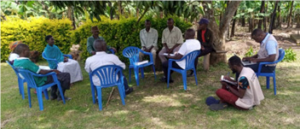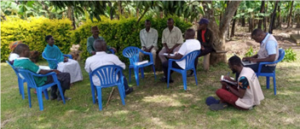 |
Edirisa Juniour NsubugaBSc. HND (KYU), MPHN (MUK),DCMCH Host Site: Ministry of Health, Uganda National Expanded Program on Immunization
|
|||
ABOUT THE FELLOWEdirisa Juniour Nsubuga is a certified Advanced Field Epidemiology Fellowship graduate. He holds a master’s degree in Public Health Nutrition (MPHN) from Makerere University (School of Public Health), a bachelor’s of science (Hons) degree in Human Nutrition and Dietetics (BSc. HND) from Kyambogo University, a Diploma in Clinical Medicine and Community Health (DCMCH) from Fort Portal School of Clinical Officers, a Postgraduate Certificate in Enhancing Academic Qualifications in Teaching and Research in Public Health and a Postgraduate Certificate in Planetary Boundaries and Public Health from the Heidelberg Institute of Global Health (HIGH), Universität Heidelberg. As an epidemiologist, he has interest in disease outbreak investigations and response, vaccine preventable diseases, global health security, maternal and child heath, and nutritional epidemiology. During his time as a fellow, he was attached to the Uganda National Expanded Program on Immunization (UNEPI) at the Ministry of Health. Through the advanced field epidemiology training, he has networked and attained skills and competencies in interpersonal and effective communication in leadership, strategic thinking in leadership, management and leadership, mentoring, coaching and support and supervision in leadership, outbreak investigation and response including data analysis, interpretation and use. Achievements at the Host Site
Fellowship program specific achievementsOutbreaks and other public health emergency response investigations led:
Outbreaks and other public health emergency response investigations participated in:
Baylor College of Medicine, Uganda, conducted dialogue meetings among district leaders from the Rwenzori and Bunyoro regions on self-efficacy, willingness to receive and attitudes towards the COVID-19 vaccines in May 2021. I led the study that assessed the self-efficacy, attitudes and willingness to receive the COVID-19 vaccines by the district leaders pre and post the meetings. Written communication
Conference presentations
Mentorships and trainings conducted:
Summary of Epidemiological Study:Title: Measles Outbreak in Semuto Subcounty, Nakaseke District, Uganda, June–August 2021 Background: Semuto Subcounty reported rubella/ measles outbreaks in 2020 and 2021. We investigated the measles outbreak in 2021 to determine the scope, assess factors associated with transmission, estimate vaccine coverage and effectiveness, and recommend evidence-based control measures. Methods: We defined a probable case as acute onset of fever and generalized maculopapular skin rash with ≥1 of cough, cold, or red eyes in a resident of Semuto Subcounty, Nakaseke District, from June 1–August 31, 2021. A confirmed case was a probable case with a blood sample positive for measles-specific IgM. We reviewed medical records and used snowballing to identify cases. We conducted a 1:4 village-matched case‒control study to identify associated factors. A control was a randomly sampled person aged 6 months-9 years without signs/ symptoms of measles from June 1– August 31, 2021, residing in the same village as the case. We used Epi Info to obtain adjusted Mantel‒Haenszel odds ratios (ORMH) and confidence intervals (CIs) and calculated vaccine coverage and effectiveness. Results: We identified 30 case persons (3 confirmed); 16 (53%) were male, and none died. The overall subcounty attack rate (AR) was 3.2/1000. Children aged 5-9 years were the most affected (AR=5.0/1,000). Twenty-two (79%) case-persons and 116 (97%) control-persons had ever received measles vaccine (ORMH=0.13, 95% CI: 0.03- 0.52). Interaction with symptomatic persons at water collection points (ORMH=4.4, 95% CI: 1.6-12) and playing at community playgrounds (ORMH=4.2, 95% CI: 1.7-11) during the exposure period increased the odds of infection. Vaccination coverage was 97% (95% CI: 92-99%), and vaccine effectiveness was 87% (95% CI: 48-97%). Conclusion: Socializing and congregating at water collection points and community playgrounds facilitated measles transmission in this outbreak. Measles vaccination was protective. We recommended mass community vaccination (or re-vaccination) for children in Semuto Subcounty to capture unvaccinated children and act as a second dose in those who received only one dose. We urged parents/guardians to recognize, isolate, and keep children with measles-like symptoms at home. Key lessons learnt during the fellowshipDuring the fellowship, I learned and developed the following skills:
Next Steps
Pictorial
|
||||
Sign in
Sign in
Recover your password.
A password will be e-mailed to you.



